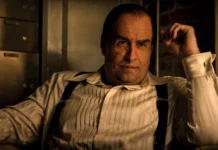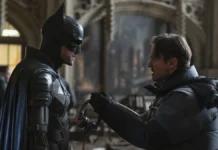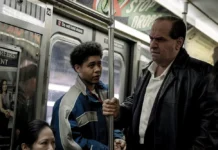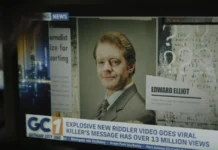By Trey Jackson
EDITOR’S NOTE: The opinions expressed in this guest op-ed are those of the author. They do not purport to reflect the opinions or views of Batman-On-Film.com, its Founder/EIC, or any other BOF contributor.
 I loved THE BATMAN.
I loved THE BATMAN.
I loved the character-driven approach, the detective work, the mystery angle, and the general vibe of the movie. The cast was excellent, the score is incredible, and the story makes the three hours fly by.
I don’t think it’s perfect, but it is compelling. Mainly, what sticks with me are the themes Matt Reeves is presenting and how he’s weaving them into a Batman story. These are the ones that stood out to me the most.
The Importance of Fathers
Fathers are what drive this whole movie. Their presence, their absence, and how they treat their families — these things are the catalysts for everything we see. On one hand, you have Thomas Wayne, who wanted to help the city with his wealth and public works. His renewal fund is an attempt to do this almost as a paternal figure to the city. But you also have Carmine Falcone who takes advantage of the Renewal Project to gain power and causes the suffering of those around him, suffering that is personified in his daughter Selina. And don’t forget the father we don’t even know, the absent father of Edward Nashton, whose absence Edward never recovers from.
Speaking of whom, did you happen to notice all the similarities between Bruce and The Riddler? The obvious is that they’re both orphans. They both believe they have a mission to fight the problems that plague Gotham. They both prefer wearing a mask while doing so. They both keep journals. With both, the movie shows us their almost voyeuristic perspective multiple times. They both scrawl things across the floor to piece everything together, and both are rocked by what they discover with Renewal. The Riddler certainly notices some of these similarities, though he doesn’t know that Bruce is Batman, so he thinks Batman is a kindred spirit while he seethes with envy over Bruce’s life after the tragedy. The Riddler believes the key difference between him and Bruce is Bruce’s money and luxury. But we know better. Bruce is far from well-adjusted, at times barely hanging on to sanity. So what is the key difference between Bruce and Riddler?
A father figure, namely Alfred.
Bruce has a father to step in when Thomas dies. The Riddler doesn’t. I think it really is as simple as that. Alfred regrets that he couldn’t be more of a father to Bruce and even says so, but Bruce’s journey to heroism in this movie shows that Alfred’s commitment to him did matter in a profound way.
Fathers and their actions are the source of the problems in this movie, but also the solutions. Remember when Bruce first sees the mayor’s son after the mayor has been murdered? He doesn’t want to leave because he knows what that kid is about to go through. Similarly, at the funeral scene, Bruce knows how hard his life will be, and steps in to protect him when he’s in danger. And who reaches for Batman’s hand first when the floodwaters are rising? The same kid, the one that Bruce has been wanting to help the entire movie. The whole finale is showcasing Batman moving away from vengeance towards heroism and yes, even towards being a protective father figure to those in need. One of my favorite scenes is when Batman puts the woman on the gurney to be taken away and she doesn’t want to let go, and he must assure her that she will be okay. That’s what fathers do, and now that’s what Batman does.
Floods
It rains a lot in this movie.
Seriously, you wonder how the sea walls held up for as long as they did. Ultimately, we do see that they are fragile, just as fragile as the attempts to hide the corruption and evil under the surface in Gotham.
Did you notice the scenes where it wasn’t raining, and what was happening in those scenes? I may be misremembering (I’ve seen it twice at the time of writing this) but I counted the mayor’s funeral, the scenes between Selina and Bruce at the Batsignal, Falcone’s arrest, and the final scene when Bruce and Selina part ways. Maybe you can recall more, but as I think about them, every scene where it wasn’t raining contained a moment where Bruce connected with someone. He realized how much he could still care about those around him, a preview of life without being detached and vengeful…a life after the rain and the flood.
Flooding the city at the end is an incredible visual, but it’s also a practical payoff from where the movie has taken us. Gotham is as soaked by corruption as it is by rain. The movie shows us this over and over. And only a fragile barrier is holding back the rain and hiding the corruption until The Riddler comes along and blows them both up.
This is a very Old Testament approach to judgment and justice, where the floodwaters symbolize all the death and destruction that finally drowns you. Think of the story of Noah, where we’re told the earth was “corrupt and full of violence.” Does that sound like Gotham to anyone else?
Not to get too theological, but water is a powerful symbol because it takes life as well as gives it. Water’s role in baptism is to wash off the old ways and put them to death so that the person can be reborn into a new life. That’s Batman at the end of this movie, not having the effect he expected, but the one Gotham needs as part of his new heroic life.
Hope
I doubt I’ll ever hear Ave Maria again without being a little unsettled.
It’s a great example of how to use a piece of music in a movie to underscore what the movie wants to tell us. For anyone who doesn’t know, Ave Maria is the Latin name for Hail Mary, a traditional Christian prayer to Mary. The song is from composer Franz Schubert, and the lyrics of his arrangement include some of the words from the traditional prayer. The prayer is from the perspective of sinners asking for Mary to pray to God on their behalf at the time of their death. The song picks up on this and adds elements of someone singing a prayer to Mary while in great despair, with death and evil closing in on them prompting them to turn to Mary for deliverance.
So why is this The Riddler’s theme? Think about it from his perspective: He believes he is bringing justice and victory to Gotham, and that he is fighting corruption all around him. And he thinks Batman is a partner in his crusade. So that helps us understand why he might sing it. But he’s clearly evil, so why does the movie want us to associate the song with him and his actions in several key scenes? Think about who is actually in need of saving in this movie. The people of Gotham certainly are. But who has to be saved from a dead-end life of vengeance first in order to become a hero? Batman is the one who must die and rise again to new life. He’s the one who must turn from despair toward hope. And it’s his arc that I think ties everything together. The rain and floods symbolize the death and rebirth that he and then Gotham must undergo. His father Thomas Wayne sets the story in motion, and his father figure Alfred is what keeps him from losing himself completely and suffering the same fate as The Riddler. And hope is what he ultimately finds, hope that he can save those he cares about, and hope that he inspires in those he saves. The kind of hope that those who sing Ave Maria are really praying for.
As I said, I loved THE BATMAN, and it’s in no small part due to how thematically rich it is. These are the things I noticed, but I’d love to hear what others picked up on. I think this is the kind of movie that will keep on giving as we re-watch it for years to come. – Trey Jackson
Follow Trey on Twitter: @TreyJackson619













